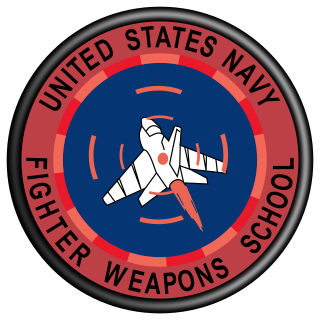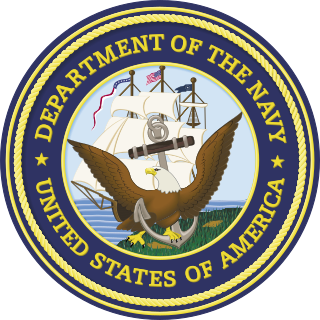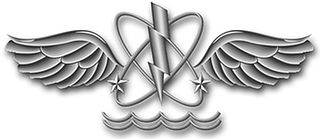
The United States Naval Research Laboratory (NRL) is the corporate research laboratory for the United States Navy and the United States Marine Corps. It conducts basic scientific research, applied research, technological development and prototyping. The laboratory's specialties include plasma physics, space physics, materials science, and tactical electronic warfare. NRL is one of the first US government scientific R&D laboratories, having opened in 1923 at the instigation of Thomas Edison, and is currently under the Office of Naval Research.

The United States Navy Strike Fighter Tactics Instructor program, more popularly known as TOPGUN, teaches fighter and strike tactics and techniques to selected naval aviators and naval flight officers, who return to their operating units as surrogate instructors. It began as the United States Navy Fighter Weapons School, established on 3 March 1969, at the former Naval Air Station Miramar in San Diego, California. In 1996, the school was merged into the Naval Strike and Air Warfare Center at Naval Air Station Fallon, Nevada.

Pacific Missile Test Center (PMTC) is the former name of the current Naval Air Warfare Center, Weapons Division. The name of the center was the Naval Air Missile Test Center prior to PMTC. It is located at Naval Base Ventura County/Naval Air Station Point Mugu in Ventura County, California. The nearest city to the installation is Oxnard.
ADDIE is an instructional systems design (ISD) framework that many instructional designers and training developers use to develop courses. The name is an acronym for the five phases it defines for building training and performance support tools:

The United States Naval Surface Warfare Center Dahlgren Division (NSWCDD), named for Rear Admiral John A. Dahlgren, is located in King George County, Virginia, in close proximity to the largest fleet concentration area in the Navy. NSWCDD is part of the Naval Surface Warfare Centers under the Naval Sea Systems Command (NAVSEA). NSWCDD was initially established 16 October 1918 as a remote extension of Maryland's Indian Head Proving Ground used for testing naval guns. The Dahlgren site was named the Lower Station, Dahlgren Naval Proving Ground when it first opened. The location on the Potomac River was specifically chosen for the development of a long ballistic test range on the Potomac River, required for the testing of modern, high-powered munitions.

The Naval Air Systems Command (NAVAIR) provides materiel support for aircraft and airborne weapon systems for the United States Navy. It is one of the Echelon II Navy systems commands (SYSCOM), and was established in 1966 as the successor to the Navy's Bureau of Naval Weapons.

The Naval Aviation Warfighting Development Center was formerly known as the Naval Strike and Air Warfare Center at Naval Air Station Fallon located in the city of Fallon in western Nevada. It is the center of excellence for naval aviation training and tactics development. NAWDC provides service to aircrews, squadrons and air wings throughout the United States Navy through flight training, academic instructional classes, and direct operational and intelligence support. The name was changed from NSAWC to NAWDC to align with the naming convention of the Navy's other Warfighting Development Centers (including Naval Surface and Mine Warfighting Development Center, Naval Information Warfighting Development Center, and the Undersea Warfighting Development Center.

Naval Air Warfare Center Warminster was a U.S. Navy military installation located in Warminster, Pennsylvania and Ivyland, Pennsylvania. For most of its existence (1949–1993), the base was known as the Naval Air Development Center (NADC) Warminster, but it has also been referred to as Johnsville Naval Air Development Center, NADC Johnsville or simply, Johnsville.

Michael James Foreman is a retired U.S. Navy pilot and a NASA astronaut. While with NASA, Foreman was part of a mission that delivered the Japanese Experiment Module and the Canadian Special Purpose Dexterous Manipulator to the International Space Station. Foreman was also a crewmember of the STS-129 mission in November 2009. In 2018, he was elected mayor of Friendswood, Texas. His wife Lorrie is a civil engineer.

Naval Base Ventura County (NBVC) is a United States Navy base in Ventura County, California. Formed by the merger of NAS Point Mugu and CBC Port Hueneme, NBVC is a diverse installation composed of three main locations — Point Mugu, Port Hueneme, and San Nicolas Island. The base serves as an all-in-one mobilization site, deep water port, railhead, and airfield. NBVC supports more than 100 tenant commands with a base population of more than 19,000 personnel, making it the largest employer in Ventura County.

The Naval Air Warfare Center Training Systems Division (NAWCTSD) is an Echelon IV command of the United States Navy, reporting to the Commander, Naval Air Warfare Center - Aircraft Division (NAWCAD) at NAS Patuxent River, Maryland. NAWCTSD is located in Orlando, Florida in the Central Florida Research Park, adjacent to the University of Central Florida (UCF). The facility is a part of a larger military installation within the Central Florida Research Park known as Naval Support Activity Orlando.

The Naval Aircrewman rating is an enlisted rating of the US Navy. It was previously designated as aviation anti-submarine warfare operator. However, under the CNO-directed "Helicopter Master Plan", all 78XX and 94XX aircrewmen were re-designated as "aviation warfare systems operators". The description of the Naval Aircrew Rate (AW) on this page define only the "Active Duty" aspects of the AW rate, fleets (aircraft), positions, and duties that are manned by aircrew in today's Navy. The Full Time Support (FTS) and Selected Reserves (SELRES) components of the U.S. Naval Reserves make up the largest number of Aircrew in today's Navy. Many technologically advanced navies have a similar trade.

The Pakistan Marines or simply as Pak Marines, is an expeditionary and amphibious warfare uniform service branch within the Pakistan Navy, consisting of the naval officers and other personnel to perform their duties within the Marines. Pakistan Marines are responsible for providing force protection in littorals, using the mobility of the Pakistan Navy to provide creeks defence, ground based air defence and Force protection.

The Navy Supply Corps School (NSCS) is a 27-week training and "Basic Qualification Course" (BQC) in the United States located in Newport, Rhode Island. Those who complete the course become Commissioned officers in the Navy Supply Corps. The commanding officer is Capt. Michael York.

Naval Support Activity Panama City, is a military shore installation of the United States Navy located in Bay County, just outside Panama City, Florida. Among its various tenant commands, it houses the Naval Surface Warfare Center Panama City Division, the Center for Explosive Ordnance Disposal & Diving (CENEODDIVE), the Navy Experimental Diving Unit (NEDU), and Coast Guard Station Panama City.

The Operational Test and Evaluation Force (OPTEVFOR) serves as an independent and objective agency within the United States Navy for the operational testing and evaluation (OT&E) of naval aviation, surface warfare, submarine warfare, C4I, cryptologic, and space systems in support Navy and U.S. Department of Defense acquisition programs.
The United States Navy job rating of electronics technician (ET) is a designation given by the Bureau of Naval Personnel (BUPERS) to enlisted members who satisfactorily complete initial Electronics Technician "A" school training.

The Gunnery Division was a Directorate of the Admiralty Naval Staff of the Royal Navy responsible for the tactical use of naval weapons and the training of naval personnel in relation to operational requirements. It was established in 1920 when the Gunnery and Torpedo Division was separated into an independent Gunnery Division and Torpedo Division. It existed until 1964 when the Department of Admiralty was abolished and replaced by a new Ministry of Defence.


















